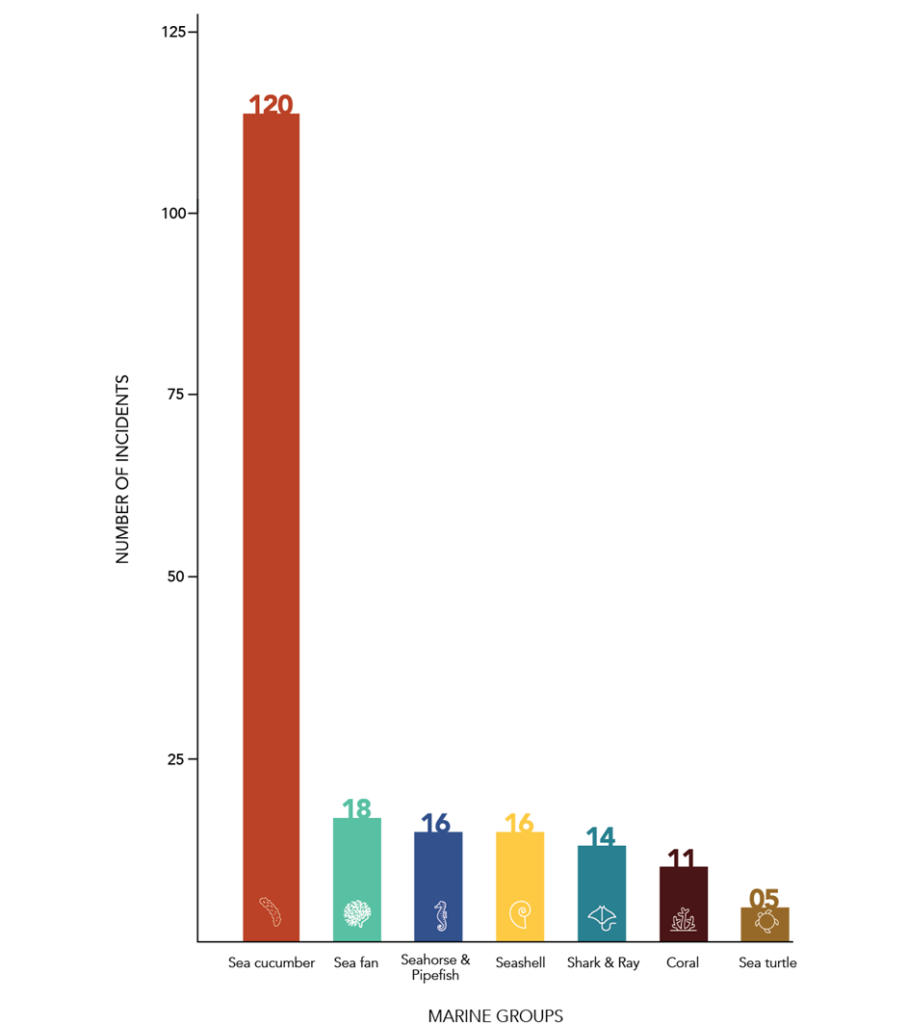
Green Minute News:
Illegal trading in marine wildlife species in India continues unabated which often goes unreported. Between January, 2015-December, 2021, just187 incidents of illegal trading were reported in the media which were collectively analysed in a report prepared by scientists of Wildlife Conservation Society (WCS)-India.
Analysis revealed that the most traded species was the “Sea Cucumber” (121 incidents) followed by Sea Fan (20), Seahorse and Pipefish (18) and Seashell (18). Tamil Nadu recorded the highest number of seizures involving illegal marine wildlife (126 incidents), followed by Maharashtra (13), Lakshadweep (12) and Karnataka (8).

Presently, India is an identified hotspot for illegal smuggling and trading in Sea Cucumbers. This is to supply demand for bêche-de-mer from south east Asia. Sea fans (known as ‘Indra-jaal’ or ‘Maha-jaal’) are sold within the country due to local superstitious beliefs. Further, trading was not only restricted to coastal areas, but also recorded in Assam, Uttar Pradesh, Rajasthan, and central Karnataka. Online trading of sea fans was also recorded.
Nirmal U Kulkarni, Senior Consultant CWT program adds, “The illegal wildlife marine trade has spiked to unprecedented proportions in the past decade with indications of organised networks now active on India’s Western and Eastern coasts. While enforcement agencies have stepped in equal measure to curb this illegal trade in endangered marine species, community outreach programs will play a critical role in providing long term solutions to targeted harvests of illegal marine wildlife including sea fans, sharks, sea cucumbers, various species of shells, etc.”

The WCS report on Illegal Trade of Marine Species in India: 2015-2021 aims at providing a comprehensive overview of the illegal marine wildlife trade. According to the Counter Wildlife Trafficking team of WCS-India, data collected for seven groups of marine wildlife species were analysed within the report, which includes sea cucumber, coral, syngnathidae (seahorse and pipefish), elasmobranch (shark and ray), seashell, sea fan and sea turtle.
Dr Vardhan Patankar, Marine Biologist states, “Illegal marine trade, although common, it often goes unreported due to the nature of the trade and as a result, civil society, policymakers and local communities are left in the dark about the instances and scale of the problem, making it hard to investigate, report and analyse.”

Trading in a variety of protected “Seashell” species were recorded through seizures in this assessment. These were often traded along with corals and sea fans. Seashells are commonly sold in curio markets along the coastline, and have a demand in the ornamental industry.
For instance, species like Trochus shell (Trochus niloticus) are prized for their lustre and are used to extract mother-of-pearl and design artefacts while windowpane oysters (Placuna placenta) are used as design for lamps, hair clips and other accessories.

Dr Aaron Savio Lobo, Senior Advisor Marine program said,“When it comes to illegally traded marine wildlife, the largest volumes are harvested as incidental catch in unselective fisheries such as trawling and gillnetting. This includes the likes of seahorses, sharks, manta, and devil rays.”
So, countering marine wildlife trade requires paradigm changes in fisheries management as whole to reduce their capture in the first place, he adds.

The WCS report attempts to provide a baseline of illegal marine trade in India. It also aims to reiterate the importance of enforcement agencies to counter marine wildlife trade. Marine wildlife covers a wide array of species spanning across taxonomic groups, with varying levels of usage, threats, and protection status.
Hence, interventions to reduce marine wildlife crime warrants effective policy measures, support from coastal communities, and increased awareness on the importance of marine wildlife and its habitats.
